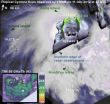(Press-News.org) ITHACA, N.Y. – Global travel and climate warming could be creating the right conditions for outbreaks of a new virus in this country, according to a new Cornell University computer model.
The model predicts that outbreaks of chikungunya, a painful virus transported by travelers and spread by the invasive Asian tiger mosquito, could occur in 2013 in New York City during August and September, in Atlanta from June through September, and year-round in Miami. The probability of a disease outbreak is correlated with temperature, as warmer weather allows the Asian tiger mosquito to breed faster and grow in numbers, according to the study published in the November issue of PLOS Neglected Tropical Diseases.
According to the simulation, there is a high probability of a chikungunya outbreak if a single infected person arrives in New York in July or August and is bitten by an Asian tiger mosquito. The risks are the same, but with wider time frames, for transmission in Atlanta and Miami, according to the paper.
Asian tiger mosquitoes were introduced to the United States in Texas in the 1980s; they are established up the East Coast into New Jersey and are rising in numbers in New York City. The aggressive mosquito outcompetes local varieties and transmits more than 20 pathogens, including chikungunya and dengue, said Laura Harrington, associate professor of entomology and the study's senior author.
"The virus is moving in people, and resident mosquito populations are picking it up," Harrington said.
The model estimates that with typical regional temperatures, a chikungunya outbreak in New York would infect about one in 5,000 people, said Diego Ruiz-Moreno, a postdoctoral associate and the paper's lead author
"However, this number would increase drastically as temperatures rise due to climate change," Ruiz-Moreno said.
Chikungunya symptoms include a fever, severe joint pain, achiness, headache, nausea and fatigue, as well as "debilitating and prolonged" pain in the small joints of the hands and feet, according to the paper. The virus originated in Central Africa and is endemic in Southeast Asia.
Since no chikungunya vaccine exists, U.S. residents can help prevent an outbreak by removing standing water, wearing long sleeves and repellent during the day when the mosquitoes feed, and knowing the risk and symptoms when traveling, Harrington said.
###
The study was funded by a National Institute for Food and Agriculture Hatch grant and Cornell's Atkinson Center for a Sustainable Future Climate Change and Disease Program.
Contact the Press Relations Office for information about Cornell's TV and radio studios.
Chances seen rising for chikungunya outbreaks in NYC, Atlanta, Miami
2012-12-18
ELSE PRESS RELEASES FROM THIS DATE:
Plumes across the Pacific deliver thousands of microbial species to West Coast
2012-12-18
A surprising number of microorganisms – 99 percent more kinds than had been reported in findings published just four months ago – are leaping the biggest gap on the planet. Hitching rides in the upper troposphere, they're making their way from Asia across the Pacific Ocean and landing in North America.
For the first time researchers have been able to gather enough biomass in the form of DNA to apply molecular methods to samples from two large dust plumes originating in Asia in the spring of 2011. The scientists detected more than 2,100 unique species compared to only ...
2 cups of milk a day ideal for children's health, new research shows
2012-12-18
TORONTO, Dec. 17, 2012—New research has answered one of the most common questions parents ask their doctors: How much milk should I be giving my children? The answer is two cups per day.
"We started to research the question because professional recommendations around milk intake were unclear and doctors and parents were seeking answers," said Dr. Jonathon Maguire, a paediatrician at St. Michael's Hospital and the lead author of the study.
Dr. Maguire and his team looked at how cow's milk affected body stores of iron and vitamin D – two of the most important nutrients ...
Dust-plumes power intercontinental microbial migrations
2012-12-18
Along with pollutants from Asia, transpacific dust plumes deliver vast quantities of microbes to North America, according to a manuscript published online ahead of print in the journal Applied and Environmental Microbiology.
"We detected thousands of unique microbial species, many of which seem particularly well-suited for atmospheric transport," says first author David J. Smith, a graduate student at the University of Washington, Seattle. "We also detected archaea, a domain of life that has never before been sampled at high altitude. We are just starting to understand ...
RIT scientists decode 3 bacterial strains common to grapevines and sugarcane
2012-12-18
Scientists at Rochester Institute of Technology have published the whole genome sequence of bacteria associated with Jamaican sugarcane and Riesling grapevines in the September and November issues of the Journal of Bacteriology, a publication of the American Society for Microbiology.
André Hudson and Michael Savka, professors in RIT's Thomas H. Gosnell School of Life Sciences within the College of Science, isolated and identified three bacteria belonging to the genus Enterobacter from Jamaican sugarcane stalk tissue and Methylobacterium and Novosphingobium from grapevines.
These ...
Notre Dame's Reilly Center highlights emerging ethical dilemmas in science and technology
2012-12-18
As a new year approaches, the University of Notre Dame's John J. Reilly Center for Science, Technology and Values has announced its first annual list of emerging ethical dilemmas and policy issues in Science and Technology for 2013.
The Reilly Center explores conceptual, ethical and policy issues where science and technology intersect with society from different disciplinary perspectives. Its goal is to promote the advancement of science and technology for the common good.
The center generated its first annual list of emerging ethical dilemmas and policy issues in science ...
People with HIV hospitalized less often since combination antiretroviral drug therapy introduced
2012-12-18
TORONTO, Dec. 17, 2012—People with HIV are being hospitalized in Ontario significantly less often than they were 15 years ago when combination antiretroviral drug therapy (cART) was introduced, new research has found.
However, women with HIV are still hospitalized more than men with HIV as are low-income people with HIV compared with high-income people with HIV, according to a study by Tony Antoniou, a pharmacist and researcher in the Department of Family Medicine at St. Michael's Hospital.
Immigrants with HIV who had been in Ontario three years or less had lower rates ...
Following Phragmites home
2012-12-18
Phragmites australis, an invasive species of plant called common reed, grows rapidly into dense stands of tall plants that pose an extreme threat to Great Lakes coastal wetlands. Early treatment is the key to controlling Phragmites.
But how can these invasive reeds be eradicated before they take over their environment if we don't know where they are?
Now we do know, thanks to scientists from Michigan Technological University's Michigan Tech Research Institute (MTRI), the US Geological Survey (USGS), Boston College and the US Fish and Wildlife Service (USFWS). They mapped ...
NASA sees dangerous category 4 Cyclone Evan lashing Fiji
2012-12-18
Cyclone Evan is one of the strongest cyclones to affect Fiji in almost two decades, and NASA satellites are analyzing the storm and providing data on rainfall, cloud height, temperature data and more to forecasters.
According to NBC News, over 3,500 people in Fiji went to emergency shelters. Today, Dec. 17, Evan is lashing Fiji, just days after battering Samoa where it killed at least three people and left thousands homeless.
On Monday, Dec. 17 many warnings and watches were in effect. A tropical cyclone warning is in effect for Fiji. A Hurricane warning is in effect ...
A need to look again: TRMM satellite observations of Tropical Cyclone Evan
2012-12-18
The radar on NASA's Tropical Rainfall Measuring Mission (TRMM) satellite had observed Tropical Cyclone Evan four times as of Sunday, Dec. 16, and two of those overflights merit a closer examination.
On Tuesday, Dec. 11, the TRMM satellite saw Evan about 24 hours before the storm struck American Samoa, and the radar data at first seem incongruous for such a weak system. At the time, Evan was estimated to be less than tropical "cyclone" strength, and had 35 knot (40.2 mph/64.8 kph) surface winds, making it a tropical storm. More specifically, the TRMM radar saw a "complete ...
Univ. of MD School of Medicine to study drug-resistant malaria in Myanmar
2012-12-18
University of Maryland School of Medicine researchers have launched groundbreaking research into the spread of potentially deadly drug-resistant malaria in the developing Southeast Asian nation of Myanmar, also known as Burma. The scientists, working as part of a large international team coordinated by the World Health Organization (WHO), have identified several promising genetic markers that could be used to develop tests to identify and track the spread of the newest type of drug-resistant malaria in Southeast Asia, including Myanmar. The scientists describe these new ...



